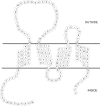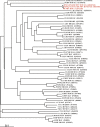Identification of the gene encoding Brain Cell Membrane Protein 1 (BCMP1), a putative four-transmembrane protein distantly related to the Peripheral Myelin Protein 22 / Epithelial Membrane Proteins and the Claudins
- PMID: 11472633
- PMCID: PMC35279
- DOI: 10.1186/1471-2164-2-3
Identification of the gene encoding Brain Cell Membrane Protein 1 (BCMP1), a putative four-transmembrane protein distantly related to the Peripheral Myelin Protein 22 / Epithelial Membrane Proteins and the Claudins
Abstract
Background: A partial cDNA clone from dog thyroid presenting a very significant similarity with an uncharacterized mouse EST sequence was isolated fortuitously. We report here the identification of the complete mRNA and of the gene, the product of which was termed "brain cell membrane protein 1" (BCMP1).
Results: The 4 kb-long mRNA sequence exhibited an open-reading frame of only 543 b followed by a 3.2 kb-long 3' untranslated region containing several AUUUA instability motifs. Analysis of the encoded protein sequence identified the presence of four putative transmembrane domains. Similarity searches in protein domain databases identified partial sequence conservations with peripheral myelin protein 22 (PMP22)/ epithelial membrane proteins (EMPs) and Claudins, defining the encoded protein as representative of the existence of a novel subclass in this protein family.Northern-blot analysis of the expression of the corresponding mRNA in adult dog tissues revealed the presence of a huge amount of the 4 kb transcript in the brain. An EGFP-BCMP1 fusion protein expressed in transfected COS-7 cells exhibited a membranous localization as expected. The sequences encoding BCMP1 were assigned to chromosome X in dog, man and rat using radiation hybrid panels and were partly localized in the currently available human genome sequence.
Conclusions: We have identified the existence in several mammalian species of a gene encoding a putative four-transmembrane protein, BCMP1, wich defines a novel subclass in this family of proteins. In dog at least, the corresponding mRNA is highly present in brain cells. The chromosomal localization of the gene in man makes of it a likely candidate gene for X-linked mental retardation.
Figures







References
LinkOut - more resources
Full Text Sources
Molecular Biology Databases
Research Materials

